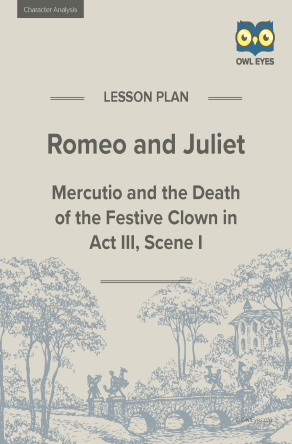Romeo and Juliet Character Analysis Lesson Plan
- 18 pages
- Subject: Character Analysis, Plot, Themes, Tone, Lesson Plans and Educational Resources
- Common Core Standards: RL.11-12.3, RL.11-12.4, RL.11-12.5
- Grade Levels: 9, 10, 11, 12
Additional Romeo and Juliet Resources
Product Description
Mercutio and the Death of the Festive Clown
This lesson plan focuses on how Mercutio’s character underscores the turning point between comedy and tragedy in Romeo and Juliet. Students will closely examine the tone, motivation, and language of Mercutio’s lines in act III, scene I in order to analyze his character and examine how his dialogue signals a transition in his character and the tone of the play. Working with their peers and as a group, students will share their observations and identify the moment when Mercutio shifts from being a comedic character to a serious one. Upon completing this lesson plan, students will be better able to explain how Mercutio’s death represents the transition from comedy to tragedy in Romeo and Juliet.
Skills: close reading, character analysis, drawing inferences from dialogue, textual interpretation
Learning Objectives: By the end of this lesson, students will be able to
- identify Mercutio’s character traits from his tone and language
- distinguish specific shifts in Mercutio’s behavior and identify the major shift in his character
- interpret the changes Mercutio undergoes in the scene
- demonstrate how these changes relate to the overall play
About This Document
Owl Eyes lesson plans have been developed to meet the demanding needs of today’s educational environment and bridge the gap between online learning and in-class instruction. The main components of each plan include the following:
- A brief synopsis of the text
- A step-by-step guide to lesson procedure
- Previous and following lesson synopses for preparation and extension ideas
- A collection of handouts and worksheets complete with answer keys
Each of these comprehensive, 60-minute plans focus on promoting meaningful interaction, analytical skills, and student-centered activities, drawing from the Common Core Standards for English Language Arts and the expertise of classroom teachers.
Introduction to the Lesson
Romeo and Juliet is one of the most famous Shakespearean tragedies in the Western canon, and it is recognized widely as the quintessential tragic love story.
It begins with Romeo and Juliet’s love-at-first-sight meeting amidst a brutal blood feud between their two families, the Capulets and the Montagues. While the play ends tragically with the two lovers’ deaths, the first half of the play includes many common tropes of Shakespearean comedy. It is driven by puns, humor, love, sonnets, and heroic couplets. In contrast, the second half features loss, revenge, death, and heartbreaking irony. Mercutio’s death at the beginning of Act III marks the play’s turning point from comedy to tragedy.
As neither a Capulet nor a Montague, Mercutio is free of boundaries in his behavior. In the role of the festive, comedic clown, he can play with words and the other characters with impunity. Though he spends most of the play making jokes and sexual innuendos, Mercutio’s loyalty and joyous spirit make him not only a lovable character but also one of the most memorable in the play.
Because Mercutio embodies the elements of Shakespearean comedy, his death marks the death of comedy within the play. Over the course of act III, scene I, Mercutio’s humorous tone and lighthearted attitude turn slowly to seriousness and anger. Through repetition, metaphors, and Mercutio’s implicit motivations, Shakespeare uses Mercutio to move the play from comedy to tragedy.
Worksheet Excerpt
“Passage Analysis Chart”: Mercutio’s Death Sequence Act III Scene I
Examine the text excerpt. For each numbered passage, answer the following questions:
- What is the tone of these lines? Which words or phrases communicate this tone?
- What is Mercutio’s Motivation in saying these lines?
- What is the intended impact of these lines?
- What does this tell us about Mercutio’s Character?







